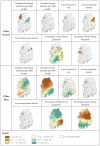The Role of Built Environment on Health of Older Adults in Korea: Obesity and Gender Differences
- PMID: 31546780
- PMCID: PMC6766019
- DOI: 10.3390/ijerph16183486
The Role of Built Environment on Health of Older Adults in Korea: Obesity and Gender Differences
Abstract
This study examines the effect of the built environment on obesity in older adults, taking into consideration gender difference. In this regard, we ask two questions: (1) How does the built environment affect obesity in older adults? (2) Is there a gender difference in the effect of the built environment? To examine the research questions, this study uses the 2015 Korean National Health and Nutrition Survey and geographically weighted regression (GWR) analysis. The empirical analyses show that environmental factors have stronger effects on local obesity rates for older men than for older women, which indicates a gender difference in obesity. Based on these findings, we suggest that public health policies for obesity should consider the built environment as well as gender difference.
Keywords: Korea; built environment; gender difference; obesity; spatial analysis.
Conflict of interest statement
The authors declare no conflict of interest.
Figures
Similar articles
-
Gender Difference and Spatial Heterogeneity in Local Obesity.Int J Environ Res Public Health. 2018 Feb 10;15(2):311. doi: 10.3390/ijerph15020311. Int J Environ Res Public Health. 2018. PMID: 29439430 Free PMC article.
-
Association of physical activity with sarcopenia and sarcopenic obesity in community-dwelling older adults: the Fourth Korea National Health and Nutrition Examination Survey.Age Ageing. 2013 Nov;42(6):734-40. doi: 10.1093/ageing/aft063. Epub 2013 Jun 11. Age Ageing. 2013. PMID: 23761456
-
Factors associated with health-related quality of life in Koreans aged over 50 Years: the fourth and fifth Korea National Health and Nutrition Examination Survey.Health Qual Life Outcomes. 2017 Dec 16;15(1):243. doi: 10.1186/s12955-017-0816-4. Health Qual Life Outcomes. 2017. PMID: 29246226 Free PMC article.
-
The built environment and older adults: A literature review and an applied approach to engaging older adults in built environment improvements for health.Int J Older People Nurs. 2018 Mar;13(1). doi: 10.1111/opn.12171. Epub 2017 Sep 21. Int J Older People Nurs. 2018. PMID: 28940674 Review.
-
How Does the Built Environment in Compact Metropolitan Cities Affect Health? A Systematic Review of Korean Studies.Int J Environ Res Public Health. 2019 Aug 14;16(16):2921. doi: 10.3390/ijerph16162921. Int J Environ Res Public Health. 2019. PMID: 31416292 Free PMC article.
Cited by
-
The Effect of High-Density Built Environments on Elderly Individuals' Physical Health: A Cross-Sectional Study in Guangzhou, China.Int J Environ Res Public Health. 2021 Sep 29;18(19):10250. doi: 10.3390/ijerph181910250. Int J Environ Res Public Health. 2021. PMID: 34639550 Free PMC article.
-
A comparative study of gender differences in healthy office building strategies.Front Psychol. 2023 Nov 27;14:1146260. doi: 10.3389/fpsyg.2023.1146260. eCollection 2023. Front Psychol. 2023. PMID: 38090183 Free PMC article.
-
Neighborhood Built Environments and Health in Later Life: A Literature Review.J Aging Health. 2025 Jan;37(1-2):3-17. doi: 10.1177/08982643231217776. Epub 2023 Nov 23. J Aging Health. 2025. PMID: 37994863 Free PMC article. Review.
References
-
- Information from the World Health Organization (WHO) [(accessed on 10 January 2019)];2019 Available online: https://www.who.int/
-
- Wadden T.A., Womble L.G. Handbook of Obesity Treatment. The Guilford Press; New York, NY, USA: 2002. pp. 105–148.
Publication types
MeSH terms
LinkOut - more resources
Full Text Sources



